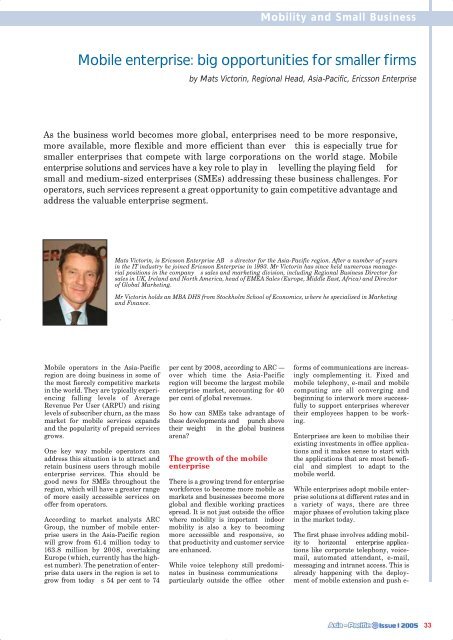Contents - Connect-World
Contents - Connect-World
Contents - Connect-World
You also want an ePaper? Increase the reach of your titles
YUMPU automatically turns print PDFs into web optimized ePapers that Google loves.
Mobility and Small Business<br />
Mobile enterprise: big opportunities for smaller firms<br />
by Mats Victorin, Regional Head, Asia-Pacific, Ericsson Enterprise<br />
As the business world becomes more global, enterprises need to be more responsive,<br />
more available, more flexible and more efficient than everthis is especially true for<br />
smaller enterprises that compete with large corporations on the world stage. Mobile<br />
enterprise solutions and services have a key role to play in levelling the playing field for<br />
small and medium-sized enterprises (SMEs) addressing these business challenges. For<br />
operators, such services represent a great opportunity to gain competitive advantage and<br />
address the valuable enterprise segment.<br />
Mats Victorin, is Ericsson Enterprise ABs director for the Asia-Pacific region. After a number of years<br />
in the IT industry he joined Ericsson Enterprise in 1993. Mr Victorin has since held numerous managerial<br />
positions in the companys sales and marketing division, including Regional Business Director for<br />
sales in UK, Ireland and North America, head of EMEA Sales (Europe, Middle East, Africa) and Director<br />
of Global Marketing.<br />
Mr Victorin holds an MBA DHS from Stockholm School of Economics, where he specialised in Marketing<br />
and Finance.<br />
Mobile operators in the Asia-Pacific<br />
region are doing business in some of<br />
the most fiercely competitive markets<br />
in the world. They are typically experiencing<br />
falling levels of Average<br />
Revenue Per User (ARPU) and rising<br />
levels of subscriber churn, as the mass<br />
market for mobile services expands<br />
and the popularity of prepaid services<br />
grows.<br />
One key way mobile operators can<br />
address this situation is to attract and<br />
retain business users through mobile<br />
enterprise services. This should be<br />
good news for SMEs throughout the<br />
region, which will have a greater range<br />
of more easily accessible services on<br />
offer from operators.<br />
According to market analysts ARC<br />
Group, the number of mobile enterprise<br />
users in the Asia-Pacific region<br />
will grow from 61.4 million today to<br />
163.8 million by 2008, overtaking<br />
Europe (which, currently has the highest<br />
number). The penetration of enterprise<br />
data users in the region is set to<br />
grow from todays 54 per cent to 74<br />
per cent by 2008, according to ARC —<br />
over which time the Asia-Pacific<br />
region will become the largest mobile<br />
enterprise market, accounting for 40<br />
per cent of global revenues.<br />
So how can SMEs take advantage of<br />
these developments and punch above<br />
their weight in the global business<br />
arena<br />
The growth of the mobile<br />
enterprise<br />
There is a growing trend for enterprise<br />
workforces to become more mobile as<br />
markets and businesses become more<br />
global and flexible working practices<br />
spread. It is not just outside the office<br />
where mobility is importantindoor<br />
mobility is also a key to becoming<br />
more accessible and responsive, so<br />
that productivity and customer service<br />
are enhanced.<br />
While voice telephony still predominates<br />
in business communications<br />
particularly outside the officeother<br />
forms of communications are increasingly<br />
complementing it. Fixed and<br />
mobile telephony, e-mail and mobile<br />
computing are all converging and<br />
beginning to interwork more successfully<br />
to support enterprises wherever<br />
their employees happen to be working.<br />
Enterprises are keen to mobilise their<br />
existing investments in office applications<br />
and it makes sense to start with<br />
the applications that are most beneficialand<br />
simplestto adapt to the<br />
mobile world.<br />
While enterprises adopt mobile enterprise<br />
solutions at different rates and in<br />
a variety of ways, there are three<br />
major phases of evolution taking place<br />
in the market today.<br />
The first phase involves adding mobility<br />
to horizontal enterprise applications<br />
like corporate telephony, voicemail,<br />
automated attendant, e-mail,<br />
messaging and intranet access. This is<br />
already happening with the deployment<br />
of mobile extension and push e-<br />
33
















